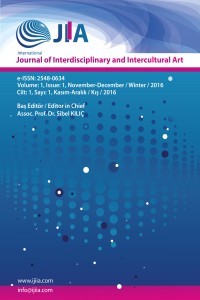IVES’IN GENERAL WILLIAM BOOTH ENTERS INTO HEAVEN’I: METİN-MÜZİK, ALINTI, BİÇİM VE GERÇEKÇİLİK İLİŞKİLERİ
Amerikalı besteci Charles Ives’ın 1914’te bestelediği General William Booth Enters into Heaven,
Vachel Lindsay’in aynı adlı şiirinin müzikal anlatım olanaklarıyla geliştirilmesinin yetkin bir örneğini
temsil eder. Bestedeki metin-müzik ilişkisi, alıntı kullanımı, eklemeli biçim (birikmeli kurulum/
cumulative setting) ve gerçekçilik anlayışı bütünlüklü bir Ives resmi çizer. Ives’ın ele aldığı metnin
kendisi bir alıntı içermekte, biçimsel olarak eklemeli/birikmeli bir kurulumla ilerlemekte ve öznel bir
deneyimin/gerçekliğin olaylar silsilesini tüm karmaşıklığı ve çoğulluğuyla sunmaktadır. Bestecinin
bu verileri müzikal düzleme taşırken içerik-biçim uyumunu titizlikle gözeterek hareket ettiği
görülmektedir. Alıntı kullanımı ile birikmeli kurulum biçimi arasında ise hem süreklilik/akış hem de
süreksizlik/parçalılık açısından doku uyumu ve işbirliği göze çarpar. Metinde ve müzikte alıntılanan
“Are You Washed in the Blood of the Lamb?” dizesi/ilahisi bu işbirliğinin kesişim kümesinde yer
alır ve Ives’ın gerçekçilik anlayışıyla da örtüşen bir biçimde parçalılık, bozukluk, belirsizlik ve
düzensizlik unsurları eşliğinde gelişerek biçimlenir. Bu makalede metin-müzik, alıntı, biçim ve
gerçekçilik başlıkları birbirleriyle ilişkili olarak ve müzikal çözümleme yöntemleri kullanılarak ele
alınmıştır. Son başlık olan gerçekçilik anlayışı ile Ives’ın üç başlıkta irdelenen müzikal ifadesinin
felsefi düzlemdeki konumu ve anlamı tartışılmış, toplamdaki dört başlığın birbirleriyle kopmaz bir
ilişki kurduğu görülmüştür. Çalışmanın amacı, metin-müzik ilişkisinin başarılı bir ürününün tüm
öğeleriyle incelenmesi suretiyle Ives’ın geliştirdiği bütünlüklü poetikaya ışık tutmaktır
Anahtar Kelimeler:
Charles Ives, Metin-Müzik İlişkisi, Alıntı, Birikmeli Kurulum, Gerçekçilik
GENERAL WILLIAM BOOTH ENTERS INTO HEAVEN OF IVES: CORRELATIONS OF TEXT-MUSIC, QUOTATION, FORM AND REALISM
General William Booth Enters into Heaven, composed by the American composer Charles Ives in
1914, represents a competent example of developing the poem of Vachel Lindsay with the possibilities
of musical expression. The composition draws an integral picture of Ives through its approach to
text-music relation, use of quotation, additive form (cumulative setting) and aspect of realism. The
text which Ives handles contains a quotation, progresses formally with a cumulative setting and
exhibits a progression of events belonging to a subjective experience/reality with all its complexity
and plurality. It’s seen that the composer acts meticulously taking care of the content-form harmony
while transporting these data to the musical platform. In case of the relationship between quotation
and form, a harmony and cooperation attracts the attention regarding both continuity/flow and
discontinuity/fragmentedness. “Are You Washed in the Blood of the Lamb?”, quoted both in the
text and the music, takes place in the intersection set of this cooperation, developing and being
formed through fragmentedness, distortion, indeterminacy and disorder, overlapping with the realist
approach of Ives. In this article, the four titles of text-music, quotation, form and realism are handled
in correlation to each other under musical analysis methods. With the aspect of realism as the last
title, Ives’ musical expression is discussed in a philosophical perspective and approved that four titles
in total establish a strong relation with each other and draw a coherent picture of Ives. The aim of
this article is to enlighten the integral poetics of Ives through the analysis of a successful product on
text-music relationship.
Keywords:
Charles Ives, Text-Music Relation, Quotation, Cumulative Setting, Realism,
___
- Burkholder, J. P. (1995). Cumulative Settings. All Made of Tunes: Charles Ives and the Uses of Musical Borrowing. London: Yale University Press.
- Copland, A. (2015), Ives Olayı. Yeni Müzik (A. C. Gedik, Çev.). İstanbul: Yazılama.
- Emerson, R. W. (1836). Nature. (Çeviri bize aittir). https://en.wikiquote.org/wiki/Ralph_Waldo_ Emerson (Erişim Tarihi: 24 Kasım 2020)
- Griffiths, P. (2010). İleriye, Geriye ve Yanlara Doğru. Batı Müziğinin Kısa Tarihi (M. Halim Spatar, Çev.). İstanbul: Türkiye İş Bankası Kültür Yayınları.
- MacDonald, C. (2005). General William Booth Enters into Heaven, https://www.hyperion-records.co.uk/tw.asp?w=W2648 (Erişim Tarihi: 24 Kasım 2020)
- Metzer, D. (2003). Chilhood and Nostalgia in the Works of Charles Ives. Quotation and Cultural Meaning in Twentieth-Century Music. New York: Cambridge University Press.
- Morgan, R. P. (1978). Ives and Mahler: Mutual Responses at the End of and Era. 19th-Century Music. 2 (1). 72-81.
- Morgan, R. P. (1992). General William Booth Enters into Heaven. Anthology of Twentieth Century Music. W. W. Norton & Company.
- Perry, R. (1974). Ives and the Transcendental Tradition. Charles Ives and the American Mind. Kent State University Press.
- Salzman, E. (1988). Ives. Twentieth-Century Music. New Jersey: Prentice Hall.
- Zinman, D. (1996). Ives: Three Places in New England / New England Holidays / They Are There! - Baltimore Symphony Orchestra & David Zinman (CD kitapçığı). (Çeviri bize aittir.) Argo.
- Başlangıç: 2016
- Yayıncı: Sibel KILIÇ
Sayıdaki Diğer Makaleler
Mehmet NORASLI, Ali AKÇAOVA, Fatih MAZLUM
OSMAN HAMDİ BEY’İN RESİMLERİNDE TİNSELLİK
Kemal YILDIRIM, Kübra MÜEZZİNOĞLU, Cem ÖZTÜRK
MAĞARA ALEGORİSİ VE GÖLGE ARKETİPİ BAĞLAMINDA ÇAĞDAŞ SANAT NESNESİ OLARAK IŞIK-GÖLGE ENSTALASYONU
DİJİTAL GİYSİ TASARIM YAZILIMLARI VE KADIN GİYİMİNDE KULLANIM OLANAKLARI
1960 SONRASI SANATTA KADIN SANATÇILARIN ESERLERİNDE FEMİNİST SANATIN ETKİLERİ
BİR ÇAĞDAŞ SANAT GÖSTERGESİ OLARAK TOPLUMUN GÖLGESİNDEKİ ÇÖPLE YÜZLEŞME
